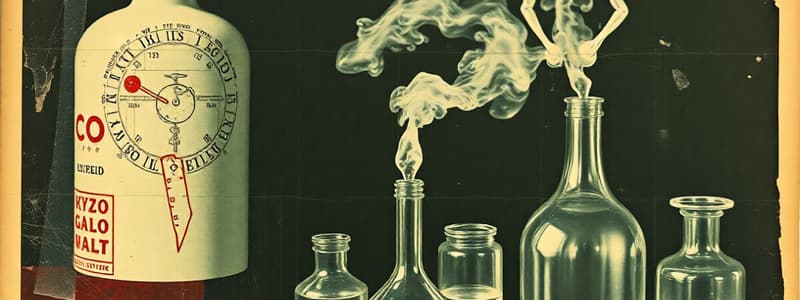Podcast
Questions and Answers
What is the expected observation when hydrogencarbonate indicator is added to tube tube filled with oxygen and shaken?
What is the expected observation when hydrogencarbonate indicator is added to tube tube filled with oxygen and shaken?
- The solution turns blue
- The solution becomes cloudy
- The solution remains red (correct)
- The solution turns yellow
What happens to the glowing splint when it is placed into a tube with oxygen?
What happens to the glowing splint when it is placed into a tube with oxygen?
- It does not change at all
- It burns brighter (correct)
- It smolders and produces smoke
- It extinguishes immediately
What should occur to lime water inside a test tube when exposed to carbon dioxide ?
What should occur to lime water inside a test tube when exposed to carbon dioxide ?
- It turns colorless
- It becomes cloudy (correct)
- It remains clear
- It turns blue
Which gas is identified if a glowing splint reignites upon insertion into a test tube?
Which gas is identified if a glowing splint reignites upon insertion into a test tube?
What characteristic of nitrogen would be observed in the experiments?
What characteristic of nitrogen would be observed in the experiments?
What safety precaution is specifically mentioned for handling gases in this experiment?
What safety precaution is specifically mentioned for handling gases in this experiment?
What is the purpose of using a glowing splint in the experiment?
What is the purpose of using a glowing splint in the experiment?
What is the main use of hydrogencarbonate indicator in the experiment?
What is the main use of hydrogencarbonate indicator in the experiment?
What material is used to identify carbon dioxide in the experiment?
What material is used to identify carbon dioxide in the experiment?
How does the smell of the gases in tubes F to J compare to those in K to O?
How does the smell of the gases in tubes F to J compare to those in K to O?
Which test is performed to check the presence of oxygen in the experiment?
Which test is performed to check the presence of oxygen in the experiment?
What should be done immediately after lighting the wooden splint for the oxygen test?
What should be done immediately after lighting the wooden splint for the oxygen test?
Which gas is indicated by the use of lime water in the experiment?
Which gas is indicated by the use of lime water in the experiment?
In the context of the experiment, why is it important to act quickly during gas testing?
In the context of the experiment, why is it important to act quickly during gas testing?
Flashcards
Testing Oxygen
Testing Oxygen
A test to identify oxygen gas.
Burning splint
Burning splint
A wooden stick that has been lit to test for oxygen.
Oxygen test method
Oxygen test method
A method used to identify oxygen gas, which involves observing the reactions of a lit splint in presence of oxygen.
Observe the colour of the gas
Observe the colour of the gas
Signup and view all the flashcards
Wooden splint
Wooden splint
Signup and view all the flashcards
Glowing splint
Glowing splint
Signup and view all the flashcards
Safety Precautions
Safety Precautions
Signup and view all the flashcards
Gas Testing
Gas Testing
Signup and view all the flashcards
Burning splint test for oxygen
Burning splint test for oxygen
Signup and view all the flashcards
Glowing splint test
Glowing splint test
Signup and view all the flashcards
Hydrogencarbonate indicator test
Hydrogencarbonate indicator test
Signup and view all the flashcards
Limewater test for carbon dioxide
Limewater test for carbon dioxide
Signup and view all the flashcards
Gas identification tests
Gas identification tests
Signup and view all the flashcards
Carbon dioxide
Carbon dioxide
Signup and view all the flashcards
Oxygen
Oxygen
Signup and view all the flashcards
Nitrogen
Nitrogen
Signup and view all the flashcards
Study Notes
Practical 7.1: Tests for Oxygen, Carbon Dioxide, and Nitrogen
- Aim: To develop tests for identifying oxygen, carbon dioxide, and nitrogen.
Apparatus and Materials
- Per Group:
- Wooden splint: 6
- Test tube rack: 1
- Test tube filled with oxygen: 5
- Gas lighter: 1
- Test tube filled with carbon dioxide: 5
- Hydrogencarbonate indicator: 1
- Test tube filled with nitrogen: 5
- Lime water: 1
- Safety Spectacles Required
Part I: Oxygen
- Procedure 1: Teacher provides five test tubes labeled A to E with oxygen.
- Procedure 2: Observe the gas in tube A and record the color in a table.
- Procedure 3: Remove stopper from tube A. Fan the gas towards your nose and record the smell.
Part I: Oxygen (Continued)
- Procedure 4: Light a wooden splint and introduce it into a test tube of oxygen. Note the observation.
- Procedure 5: Light a wooden splint, blow out the flame to create a glowing splint and introduce it into another test tube of oxygen. Note the observation.
Part II: Carbon Dioxide
- Procedure: Repeat the procedures in part 1, using test tubes labeled F through J containing carbon dioxide.
Part III: Nitrogen
- Procedure: Repeat the procedures in part 1, using test tubes labeled K through O containing nitrogen.
Results
- Oxygen: Colorless, odorless. Burning splint burns more brightly. Glowing splint relights.
- Carbon Dioxide: Colorless, odorless. Burning splint goes out. Glowing splint goes out . Hydrogencarbonate indicator changes from red to yellow. Limewater turns milky.
- Nitrogen: Colorless, odorless. Burning splint goes out. Glowing splint goes out. No significant change with hydrogencarbonate indicator or limewater.
Discussion
- Identifying Oxygen: Glowing splint will relight. Burning splint will burn more brightly.
- Identifying Carbon Dioxide: Hydrogencarbonate indicator turns from red to yellow. Limewater turns milky.
- Identifying Nitrogen: No readily available, simple identification test.
Studying That Suits You
Use AI to generate personalized quizzes and flashcards to suit your learning preferences.




